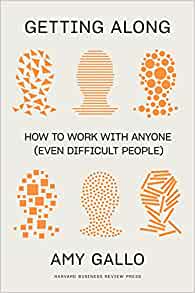Most of us don’t choose our coworkers. Yet we have to get along with them, whether we like them or not. If we can’t work together productively, there can be serious consequences, from mental health problems to business breakdown.
Author Amy Gallo has assessed this issue over many years and has published her findings and insights in a new book, “Getting Along: How to Work with Anyone (Even Difficult People).”
It’s packed with tips for dealing with specific types of difficult personality. But it also takes a bird’s-eye view of the complexity of workplace relationships, and the importance of looking after your own mental health as you navigate them.
Hang On to Your Integrity
I spoke to Gallo for our Mind Tools Expert Interview, and she spoke about staying true to yourself as you deal with difficult people.
Here’s an excerpt. (You can stream the audio clip below or read a transcript here.)
Gallo’s book examines eight archetypes of difficult people: the insecure boss, the pessimist, the victim, the passive aggressive peer, the know-it-all, the tormentor, the biased co-worker, and the political operator.
Most people will have worked with one or more of these archetypes. I certainly have. And after talking to Gallo, I realize that I could have handled those situations better.
From Pessimist to “Disagreer-in-Chief”
For instance, I remember one pessimist I worked alongside in a busy radio newsroom, who became a figure of fun for the rest of us. We laughed at her constant whining, usually behind her back, and never took the time to listen properly to her concerns.
If we had, we might have learned something. And she’d have felt like a valued member of the team and better able to do her best work. She might even have complained less.
Gallo points out that if you’re able to look beyond their difficult behavior, pessimists can serve a useful purpose, because they may flag up serious problems that the rest of us can’t see.
“You do want to hear those contrarian perspectives. You do want to hear someone who’s pointing out potential roadblocks or obstacles and what [might] happen,” she says.
“We don’t want to let it dampen the mood of the team or the motivation of the team. We don’t want them to have more power than anyone else on the team. But, if we can sort of right-size their role and hear their perspective, I think it benefits everyone.”
Gallo suggests that in some cases, pessimists could be given the role of “Disagreer-in-Chief,” charged with looking for the holes in plans or possible pitfalls ahead. That can lead to crucial conversations about mitigating the risks that they highlight.
From Victim to Validation

As well as pessimists, I’ve worked with my share of victims, who can be a tiresome suck on energy. Unlike the complaints of the doom-monger pessimist, the victim’s moaning is always just about them, and of very little use to others.
One “victim” writer I worked with – Kate – was convinced that her editor didn’t take her experience seriously. She acted like every edit was a personal slight, and went into an obvious sulk if major rewrites were requested.
Part of Gallo’s advice for working well with victims is to encourage them to take responsibility for whatever is upsetting them. Ask them directly why they believe they’re not to blame – and importantly, listen to the answer.
Kate left her job after a few painful months. If I reflect on that situation now, I can see that she may have had a point. She didn’t get on with the capricious editor-in-chief, who – yes, in retrospect – didn’t value Kate’s eclectic experience. He probably did give her a harder time than other writers on the team.
If someone had listened at the time, Kate could have been assigned to a different editor. The rewrite requests might have continued, but coming from someone else, they might have felt like valuable feedback, rather than a personal insult. This small change would have saved a lot of time and hassle recruiting her replacement.
Understanding Others’ Perspectives
Dealing with other people is complicated. Emotions flare up, positions get entrenched. But it always helps to remember that the person with the difficult behavior might be right. And we might be wrong.
Gallo says we should beware of “naïve realism”: when we think we’re seeing the truth, clear as day, but what we’re actually seeing is our own point of view.
“There are many other ways to view the situation,” Gallo says. “There’s the way your colleague sees it. There’s the way people outside the dynamic see it, your boss sees it. And those will all be different perspectives and that’s okay.”
After all, we don’t all need to agree on everything to get along. We just need to agree to get along.
Listen to the Full Story
You can listen to or read my full 30-minute interview with Amy Gallo if you’re a Mind Tools member or if your employer is a Mind Tools for Business licensee.
If you’re not already a member, join Mind Tools now to gain unlimited access to 2,400+ resources, including our back catalog of 200+ Expert Interviews. Or find out more about Mind Tools for whole organizations, big or small, by contacting our enterprise team.
Meanwhile, catch more excerpts and insights from my guests by searching our Expert Interview blog topic and by signing up free to the Mind Tools Expert Voices podcast.




